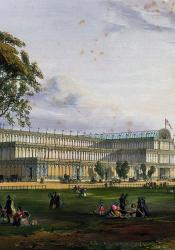The Great Exhibition of 1851
Overview
The Great Exhibition of 1851 took place in Hyde Park, London with the purpose of showcasing Britain’s conglomerate wealth and industry, both local and foreign. Royally commissioned and headed by Prince Albert, the Exhibition spanned miles, much of which was contained in the Crystal Palace, a magnificent glass construction that housed wonders from around the world––lace, furniture, diamonds, advanced agricultural machinery (Talbot), and much more were all located in one building (The Crystal Palace vii-viii). Much of the Great Exhibition’s presentation was designed to emphasize English colonial power to its many foreign visitors. Among other noteworthy authors, Charlotte Brontë visited and marveled at the Palace; in a letter to her father, she described the Exhibition, explaining, “Its grandeur does not consist in one thing but in the unique assemblage of all things… It seems as if magic only could have gathered this mass of wealth from all the ends of the Earth” (qtd. in Smith 190). Media promptly responded to the Exhibition, and ranged from the humorous to the reprehensible. Comics depicting fights between women wanting to remain in the Palace and policemen shutting it down (“The Battle of the Crystal Palace”) or America’s less-than-impressive showings were widely circulated (“The Great Exhibition”), but offensive portrayals of Turkish, Chinese, and Indian visitors with their own exhibits (“Wot is to Be”), and lengthy, racist satirical poetry detailing the displeasure of the Chinese emperor upon arriving at the Exhibition (Sutherland 2-32) also gained popularity. Following the Exhibition’s close in October of that same year, its profits were used to build other exhibitions and educational institutions (“History Plaque”).
Reflection
The Great Exhibition was heralded by a poem by William Thackeray, “May-Day Ode,” published in The Times on April 30, 1851, the day before the Exhibition opened (Smith 189). Like Charlotte Brontë, Thackeray described the Exhibition as magical: “As though ‘twere by a wizard’s rod/ A blazing arch of lucid glass/ Leaps like a fountain from the grass” (lines 5-7); however, the poem ends by rejoicing in God’s “peaceful sunlight” (line 151), combining both the religious and mystical in its representation of the Palace. The poem stands to show that along with architectural, industrial, and colonial feats, Britain also wished to display its literary prowess. The Exhibition further affected the literary world for its role in The Woman in White, where Walter Hartright describes that because the Exhibition had drawn such large foreign audiences, “Men were among us by hundreds whom the ceaseless distrustfulness of their governments had followed privately, by means of appointed agents, to our shores” (Collins 507); the Exhibition, in short, allowed a cover for Count Fosco’s evil presence in England. Collins’ usage of the Exhibition as a means toward unwanted infiltration adds another perspective to the event, painting it less as a wondrous spectacle and more as a dangerous opportunity, as if England had risked something by keeping its enemies too close. Rather than viewing the Crystal Palace with awe, The Woman in White admonishes its ostentation; perhaps England should have been more careful about who and what it let inside.
Works Cited
“The Battle of the Crystal Palace.” Wikimedia Commons, 18 Aug. 2015, https://commons.wikimedia.org/wiki/File:The_Battle_of_the_Crystal_Palace.... Accessed 1 Oct. 2022.
Brontë Charlotte. Selected Letters of Charlotte brontë. Edited by Margaret M. Smith, Oxford University Press, 2010.
Collins, Wilkie. The Woman in White (Bantam Classic). Bantam Bell, 2008.
Currier, Nathaniel. “The Great Exhibition of 1851 American Department.” Commons.wikimedia.org, 16 Nov. 2018, https://commons.wikimedia.org/wiki/File:The_great_exhibition_of_1851_Ame.... Accessed 28 Sept. 2022.
Dickinson Brothers. “Crystal Palace from the Northeast from Dickinson's Comprehensive Pictures of the Great Exhibition of 1851.” Wikimedia Commons, 13 Mar. 2016, https://commons.wikimedia.org/wiki/File:Crystal_Palace_from_the_northeas.... Accessed 26 Sept. 2022.
Edwards, H. Sutherland. An Authentic Account of the Chinese Commission: Which Was Sent to Report on the Great Exhibition: Wherein the Opinion of China Is Shown as Not Corresponding at All with Our Own. Printed at 15 and 16, Gough Square, by H. Vizetelly, and Sold by Him There ..., 1851.
Sala, George Augustus. “The Great Exhibition ‘Wot Is to Be’, Probable Results of The Industry of All Nations in The Year '51, Showing What Is to Be Exhibited, Who Is To Exhibit, in Short How Its All Going to Be Done.” Jstor, https://www.jstor.org/stable/community.18631280?searchText=creator%3A%22.... Accessed 13 Oct. 2022.
Shadowssettle. “History Plaque for the Great Exhibition, Wells Way.” Wikimedia Commons, 11 Apr. 2020, https://commons.wikimedia.org/wiki/File:History_Plaque_for_the_Great_Exh.... Accessed 29 Sept. 2022.
Talbot, Wiliam Henry Fox. “Great Exhibition, Agricutlural Implements, HF Talbot, 1851.” Wikimedia Commons, 3 Aug. 2013, https://commons.wikimedia.org/wiki/File:Great_Exhibition,_Agricutlural_I.... Accessed Oct. 2022.
Thackeray, William Makepeace. “May-Day Ode.” Ballads, by William Makepeace Thackeray, Ticknor and Company, London, Bradbury, 1862, pp. 62–68.
Unknown Author. The Crystal Palace, and Its Contents: Being an Illustrated Cyclopaedia of the Great Exhibition of the Industry of All Nations, 1851: Embellished with Upwards of Five Hundred Engravings, with a Copious Analytical Index. W.M. Clark, 1851.

